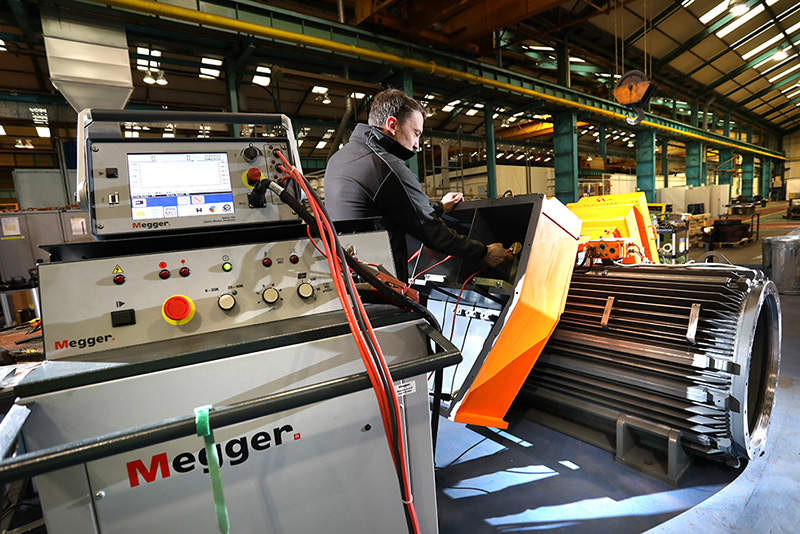
Static motor testing to support preventative maintenance programmes

It is widely understood that most common causes of electric motor failure are bearing issues, which are believed to be responsible for around 50% of failures.
This is followed by up to 30% of failures resulting from electrical insulation breakdown, which can be caused by various contributing factors.
While predictive maintenance techniques such as vibration analysis are often used to analyse the motor health, in comparison little is done to detect signs of insulation deterioration and failure.
Given that problems caused by insulation deterioration can be just as serious as those caused by worn bearings or overheating, it is just as important to assess the dielectric properties of the insulation to identify and predict early signs of insulation degradation prior to catastrophic failure.
Houghton International offer a range of non-intrusive condition monitoring including dielectric testing options, which can be carried out in situ or in our workshop as part of an inspection or planned overhaul.
These tests are designed to assess the condition of a motor’s windings, diagnose and predict any early signs of deterioration and aging and schedule repairs ahead of a catastrophic failure, which can often be very costly and result in unplanned downtime.
We use a Baker DX series and 40kV power pack PP40 tester to apply a wide set of offline electrical tests to assess the condition of motors and coil windings.
The Baker DX can find early indications of insulation weakness and faults in windings, between phases, coil-to-coil and in ground wall insulation.
The tests can identify if contamination is impacting insulation strength. It can also detect problems with connections such as feed cable insulation weakness, motor imbalances, open or high resistance.
These tests are routinely carried out in our electric motor repair shop to demonstrate the integrity of the windings and demonstrate that a motor is correctly wound and insulated, before it’s returned to the customer and put into operation.
Planned preventative maintenance (PPM)
We offer periodic offline testing and trending of the motor’s insulation systems to give an overall picture of motor insulation health.
Static or offline testing is performed while the motor is not running and can be executed on site or in our electric motor repair facility.
On-site testing is routinely implemented once or twice a year or during scheduled outages.
Recommendations on how often tests are undertaken are based on a range of factors such as criticality, past history, size, repair costs, availability of spares, daily starts and stops, and ease of access, amongst others. We work with customers to agree the most effective schedule based on their needs and the associated risks.
A complete diagnosis of the insulation system offered includes winding resistance test, a meg-ohm test, a polarization test, a step-voltage or high potential test, and a surge test – all carried out using the Baker Tester.
For higher voltage motors, 6kV and above, Partial Discharge testing can also be used to provide a wider picture of the machine health.
High voltage equipment often suffers from Partial Discharge activity, where localised corona or breakdown discharge can damage insulation, leading to progressive degradation and eventual insulation breakdown.
This type of issue would not be detected using standard diagnostic tests and it is possible for a motor to appear healthy whilst having high levels of Partial Discharge.
Compared with other dielectric tests, the differentiating character of Partial Discharge measurements allows localised weak and aged points of the insulation to be identified.
Partial Discharge testing and monitoring is particularly important when the medium or high voltage asset is critical to the operation of a network; this may be due to the asset’s age, past failures or the financial consequences of a failure.
PD measurements based on IEC 60034-27 standards can be performed on motors and generators either online during regular load service operation or off-line.
All of the above tests are carried out in accordance with IEEE, IEC and EASA standard AR100-2105, which outlines recommended practices for the repair and therefore the testing of rotating electrical apparatus. Alternatively, testing can be carried out as requested by our customers, with a bespoke testing planned developed to meet individual requirements.
Houghton International can help
Dielectric testing is a low-impact rotating machinery asset management tool allowing our customers to make informed decisions based on a full picture of reliable data.
A combination of extensive knowledge, using calibrated, top of the range equipment and highly trained and competent engineers enables us to work in partnership with our customers in managing and extending the life of their electro mechanical rotating machinery.
Get in touch with our team today to discuss how Houghton International can support your ongoing electric motor maintenance activities and reduce the risk of unplanned machine failures.
Find out more about Houghton International, here.
By Houghton International Electrical Services Ltd
949 Views
Recent Posts
- 25 years of Guardtech: Q&A with Commercial Director Mark Wheeler
- 𝗕𝗲𝗵𝗶𝗻𝗱 𝗘𝘃𝗲𝗿𝘆 𝗕𝗿𝗲𝗮𝗸𝘁𝗵𝗿𝗼𝘂𝗴𝗵 𝗜𝘀 𝗮 𝗦𝘁𝗼𝗿𝘆
- Boost Your IP Strategy: UK IPO Offers £2,250 Audit Funding
- Customs Made Simple: New GOV.UK Page Makes Import & Export Authorisations Easier to Navigate.
- Webinar: Software and Computer Implemented Inventions
Back to News >



